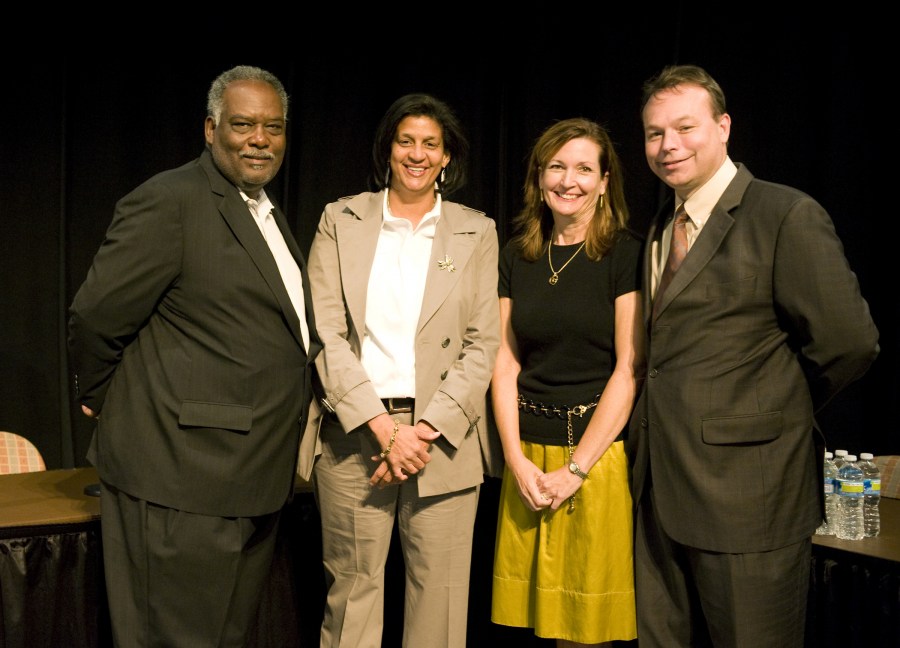
Co-chairs for this year’s Community Giving Campaign are, from left, David Williams II, MBA, J.D., Gail Carr Williams, J.D., Melinda Balser and Jeff Balser, M.D., Ph.D. (photo by Joe Howell)
Community Giving Campaign sets ambitious goal for 2010
Service to the community is an imperative part of Vanderbilt. Since the 1930s Vanderbilt University has been involved in work place giving campaigns. This year is no different.
Nearly 400 people gathered in the Student Life Center to hear the testimonies from volunteers of agencies represented in the 2010 Community Giving Campaign at Vanderbilt.

The four campaign partners — Community Health Charities, Community Shares of Tennessee, Nashville Alliance for Public Education and United Way of Metropolitan Nashville — address some of the most critical needs in Middle Tennessee.
The goal for this year's campaign is $1 million.
“I realize that this year’s goal is a little ambitious,” said Jeff Balser, M.D., vice chancellor for Health Affairs and dean of Vanderbilt University School of Medicine. “But Vanderbilt has always been an ambitious university. We spend a lot of our time educating, discovering and caring for patients. This is our chance to show the community how much we care.
“We are successful because Nashville supports us,” said Balser. “During this campaign, we get to wrap our arms around Nashville and give back to our communities.”
Balser co-chairs the campaign with his wife, Melinda, and another husband-wife duo — Gail Carr Williams, J.D., associate director of Community Engagement, Community Neighborhoods and Government Relations, and David Williams II, MBA, J.D., vice chancellor for University Affairs and Athletics, General Counsel and secretary of the University.
This is the second year the Williams' have served as chairs of the University-wide giving campaign. With more than 22,000 employees, the pair stressed the importance of participation.
“I think big. I like to spend big. But I also like to give big,” Gail Williams told the department coordinators, charged with spreading the word about the campaign.
“I want you all to think big too. Our communities need you, as cheerleaders for the campaign, to talk to your friends and co-workers about giving,” she said.
“I know we can make an impact,” continued David Williams. “This is an effort that, in the end, is a win-win for everyone involved. When we meet our campaign goals (amount of money we raise and increase participation levels) then the community wins too. The amount that you give and what agency is your choice. We just ask that you give.”
The campaign runs until Nov. 4. Over the next few weeks coordinators will spread the word about the campaign partners, which represent hundreds of charitable and public service organizations with a focus of serving communities throughout the state.
Several of the guest speakers shared information about the agencies.
William Lawson, M.D., assistant professor of Medicine in Allergy/Pulmonary and Critical Care Medicine spoke to the group about the American Lung Association, an agency of Community Health Charities.
“The American Lung Association is the primary voice for the general public about lung-related health issues and one of the most important advocates for the general community about air quality,” said Lawson. “It has been vital in the push for protecting the air we breathe.”
Kids to the Country, a Community Shares agency, helps at-risk youth from urban areas build a positive self image, develop a connection with the land and nature and diffuse anger, violence and fear.
The multi-cultural exchange program invites children ranging in age from 6-12 years old to spend four days on The Farm, a 2,000-acre community established in 1971.
“It's amazing to see how reconnecting children with nature offers them an opportunity to get out of troubled situations,” said volunteer Kay Artibee, a research nurse specialist in the Department of Neurology.
“We do a lot of community building and work on conflict resolution as well as riding horses, swimming in the river, viewing the night sky and interacting with nature. We really help them develop a different perspective of the world through this experience.”
The Nashville Alliance for Public Education has worked to identify needs of schools located in Davidson County. Jay Steele, associate superintendent for high schools with Metro Nashville Public Schools, said that giving to the Alliance is a win-win situation.
“Donations to the Alliance directly affect what is happening in the classrooms,” said Steele. “State-of-the-art equipment, better curriculums, master's-trained teachers and monies to support the strategic direction of the schools come from the Alliance.
“Investing in the schools is investing in our students and the workforce of the future,” he said. “Education is a community process.”
The fourth community giving partner is United Way of Metropolitan Nashville, an umbrella organization that supports 132 programs within 62 agencies.
Vanderbilt's Work/Life Connections Employee Assistance Program (EAP) relied heavily on the United Way during the May floods.
Jim Kendall, manager of the Vanderbilt EAP, said the United Way's 2-1-1 crisis call line was a life-saving resource that allowed his staff to better meet the needs of employees. But he pointed out that the United Way has programs in place to help people every day, not just during disasters.
“People have tough stuff going on year-round,” said Kendall. “The United Way is critical in our efforts at the EAP to meet the needs of our employees who need assistance and those seeking volunteer opportunities. It has been invaluable.”
There are several ways Vanderbilt employees can participate in the workplace giving campaign — payroll deduction, credit card or cash/check.
Online giving at www.vanderbilt.edu/communitygiving is encouraged.













